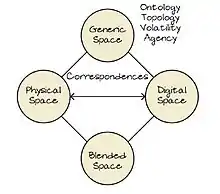Blended space
A blended space is a space in which a physical environment and a virtual environment are deliberately integrated in a close knit way. The aim of blended space design is to provide people with the experience of feeling a sense of presence in the blended space, acting directly on the content of the blended space.[1][2] Examples of blended spaces include augmented reality devices such as the Microsoft HoloLens and games such as Pokémon Go in addition to many smartphone tourism apps, smart meeting rooms and applications such as bus tracker systems.
History
The idea of blending comes from the ideas of conceptual integration, or conceptual blending introduced by Gilles Fauconnier and Mark Turner. Originally focused on understanding linguistic expressions, the simple but powerful ideas of blending have been applied to many areas as detailed on Turner's website.[3] Creative thought arises from bringing together concepts from two input spaces. These spaces have some correspondences with each other and share a structure with a more generic space. The blended space takes a partial mapping of the concepts and structure of the two input spaces to provide a new structure that demonstrates properties not possessed by either of the input spaces. Fauconnier and Turner provide many examples of blends in their book along with descriptions of different types of blend (reflecting different types of projections from the two input spaces). They also provide guidance for creating blends that are effective "at the human scale".[4]
Manuel Imaz and David Benyon introduced blending theory to look at concepts in software engineering and human-computer interaction.[5]
Describing spaces

There are two main components to any space. They are:
- Objects – The actual distinct objects which make up the medium/space. The objects thus effectively describe the space.
- Agents – Correspondents/users inside the space who interact with it through the objects.[1]
For presence in a blended space, there must be a physical space and a digital space. In the context of blended space, the higher the communication between the physical and digital spaces, the richer the experience.[1] This communication happens through the medium of correspondents which relay the state and nature of objects.
For the purpose of looking at blended spaces, the nature and characteristics of any space can be represented by these factors:
- Ontology – Different types of objects present in the space the total number of objects and the relationships between objects and the space.
- Topology – The way objects are placed and positioned.
- Volatility – Frequency with which the objects change.
- Agency – Medium of communication between the objects, and between the objects and users. Agency also encompasses the users inside the space.
Physical Space – Physical spaces are spaces which afford spatial interaction.[6] This kind of spatial interaction greatly impacts the user's cognitive model.[7]
Digital Space – Digital space (also called the information space) consists of all the information content. This content can be in any form.[8]
Structure
The simplest implementation of a blended space requires two features. The first required feature is input. The input can range from tactile, to changes in the environment. The next required feature is notifications received from the digital spaces.
The correspondences between the physical and digital space have to be abstracted and exploited by the design of the blended space. Seamless integration of both the spaces is rare. Blended spaces need anchoring points or technologies to link the spaces.[2]
A well designed blended space advertises and conveys the digital content in a subtle and unobtrusive way. Presence can be measured using physiological, behavioral, and subjective measures derived from the space.[5]
References
- Benyon, David (2014). Spaces of Interaction, Places for Experience (1 ed.). Morgan and Claypool. p. 97. ISBN 9781608457724.
- Benyon, David (July 2012). "Presence in Blended Spaces". Interacting with Computers. 24 (4): 219–226. doi:10.1016/j.intcom.2012.04.005.
- "BLENDING AND CONCEPTUAL INTEGRATION". markturner.org. Retrieved 2017-04-04.
- Fauconnier, Gilles; Turner, Mark (2002). The way we think: conceptual blending and the mind's hidden complexities. New York, NY: Basic Books. pp. 309–353. ISBN 978-0-465-08786-0.
- Benyon, David; Imaz, Manuel (2007). Designing with blends (1 ed.). Cambridge, Mass. & London: MIT Press. pp. 209–218. ISBN 9780262090421.
- Dourish, Paul. Implications for Design. Proceedings of the SIGCHI Conference on Human Factors in Computing Systems. dl.acm.org. SIGHCI. doi:10.1145/1124772.1124855.
- Buxton, Bill (2009). "Mediaspace – Meaningspace – Meetingspace". Media Space 20 + Years of Mediated Life. Computer Supported Cooperative Work. Springer. pp. 217–231. doi:10.1007/978-1-84882-483-6_13. ISBN 978-1-84882-482-9.
- Benyon, David (2012). Designing Blended Spaces (PDF). BCS-HCI '12 Proceedings of the 26th Annual BCS Interaction Specialist Group Conference on People and Computers. dl.acm.org. BCS-HCI. pp. 398–403.